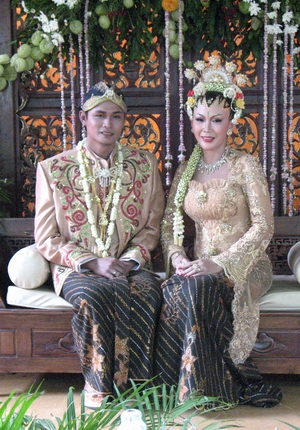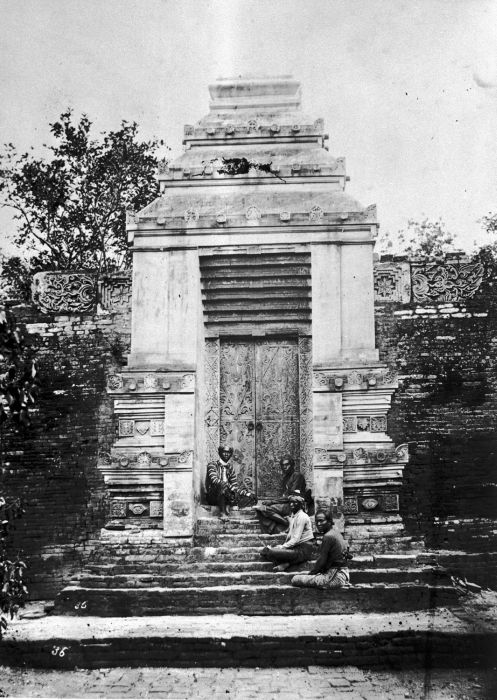|
Kris
The kris, or ''keris'' in the Indonesian language, is an asymmetrical dagger with distinctive blade-patterning achieved through alternating laminations of iron and nickelous iron (''pamor''). Of Javanese origin, the kris is famous for its distinctive wavy blade, although many have straight blades as well, and is one of the weapons commonly used in the '' pencak silat'' martial art native to Indonesia. A kris can be divided into three parts: blade ( or ), hilt (), and sheath (). Each part of the kris is considered a piece of art, often carved in meticulous detail and made from various materials: metal, precious or rare types of wood, or gold or ivory. A kris's aesthetic value covers the (the form and design of the blade, with around 60 variants), the (the pattern of metal alloy decoration on the blade, with around 250 variants), and referring to the age and origin of a kris. Depending on the quality and historical value of the kris, it can fetch thousands of dollars or more. ... [...More Info...] [...Related Items...] OR: [Wikipedia] [Google] [Baidu] |
Kalis
A kalis (Baybayin: or ; Jawi script: كاليس ; Abecedario: ''cáli'', ''cális'') is a type of double-edged Philippine sword, often with a "wavy" section. The kalis has a double-edged blade, which is commonly straight from the tip but wavy near the handle. Kalis with fully straight or fully wavy blades also exist. It is similar to the Javanese keris, but differs in that the kalis is a sword, not a dagger. It is much larger than the keris and has a straight or slightly curved hilt, making it primarily a heavy slashing weapon (in contrast to the stabbing pistol grip of the keris). The wavy portion of the kalis is said to be meant to facilitate easier slashing in battle - since a straight edge tends to get stuck in the opponent's bones, the wavy portion allows the kalis' bearer to more easily pull the weapon out of his opponent's body. This weapon was featured in the American bladesmithing competition, Forged in Fire (TV series)'s season 1 episode 8. History The predecessor ... [...More Info...] [...Related Items...] OR: [Wikipedia] [Google] [Baidu] |
Majapahit
Majapahit ( jv, ꦩꦗꦥꦲꦶꦠ꧀; ), also known as Wilwatikta ( jv, ꦮꦶꦭ꧀ꦮꦠꦶꦏ꧀ꦠ; ), was a Javanese Hindu-Buddhist thalassocratic empire in Southeast Asia that was based on the island of Java (in modern-day Indonesia). It existed from 1293 to circa 1527 and reached its peak of glory during the era of Hayam Wuruk, whose reign from 1350 to 1389 was marked by conquests that extended throughout Southeast Asia. His achievement is also credited to his prime minister, Gajah Mada. According to the () written in 1365, Majapahit was an empire of 98 tributaries, stretching from Sumatra to New Guinea; consisting of present-day Indonesia, Singapore, Malaysia, Brunei, southern Thailand, Timor Leste, southwestern Philippines (in particular the Sulu Archipelago) although the scope of Majapahit sphere of influence is still the subject of debate among historians. The nature of Majapahit relations and influences upon its overseas vassals, and also its status as an empi ... [...More Info...] [...Related Items...] OR: [Wikipedia] [Google] [Baidu] |
Javanese People
The Javanese ( id, Orang Jawa; jv, ꦮꦺꦴꦁꦗꦮ, ''Wong Jawa'' ; , ''Tiyang Jawi'' ) are an ethnic group native to the central and eastern part of the Indonesian island of Java. With approximately 100 million people, Javanese people are the largest ethnic group in Indonesia and the whole Southeast Asia in general. Their native language is Javanese, it is the largest of the Austronesian languages in number of native speakers and also the largest regional language in Southeast Asia. The Javanese as the largest ethnic group in the region have dominated the historical, social, and political landscape in the past as well as in modern Indonesia and Southeast Asia. There are significant numbers of Javanese diaspora outside of central and eastern Java regions, including the other provinces of Indonesia, and also in another countries such as Suriname, Singapore, Malaysia, Egypt, Saudi Arabia, South Africa, Sri Lanka, Yemen and the Netherlands. The Javanese ethnic group ... [...More Info...] [...Related Items...] OR: [Wikipedia] [Google] [Baidu] |
Buginese People
The Bugis people (pronounced ), also known as Buginese, are an ethnicity—the most numerous of the three major linguistic and ethnic groups of South Sulawesi (the others being Makassarese people, Makassar and Torajan people, Toraja), in the south-western province of Sulawesi, third-largest island of Indonesia. The Bugis in 1605 converted to Islam from Animism. The main religion embraced by the Bugis is Islam, with a small minority adhering to Christianity or a pre-Islamic indigenous belief called ''Tolotang''. Despite the population numbering only around six million, the Bugis are influential in the politics in modern Indonesia, and historically influential on the Malay Peninsula, Malay peninsula, Sumatra, Borneo, Lesser Sunda Islands and other parts of the Maritime Southeast Asia, archipelago where they have migrated, starting in the late seventeenth century. The third president of Indonesia, B. J. Habibie, and a former vice president of Indonesia, Jusuf Kalla, are Bugis. I ... [...More Info...] [...Related Items...] OR: [Wikipedia] [Google] [Baidu] |
Demak Sultanate
The Demak Sultanate (کسلطانن دمق) was a Javanese Muslim state located on Java's north coast in Indonesia, at the site of the present-day city of Demak. A port fief to the Hindu-Buddhist Majapahit kingdom thought to have been founded in the last quarter of the 15th century, it was influenced by Islam brought by Muslim traders from China, Gujarat, Arabia and also Islamic kingdoms in the region, such as Samudra Pasai, Malacca and Bani (Muslim) Champa. The sultanate was the first Muslim state in Java, and once dominated most of the northern coast of Java and southern Sumatra. Although it lasted only a little more than a century, the sultanate played an important role in the establishment of Islam in Indonesia, especially on Java and neighboring areas. Etymology The origin of Demak was the settlement named Glagah Wangi. According to tradition, the first person that Raden Patah encountered in Glagah Wangi was a woman named Nyai Lembah, from Rawa Pening. Nyai Lembah ... [...More Info...] [...Related Items...] OR: [Wikipedia] [Google] [Baidu] |
Mataram Sultanate
The Sultanate of Mataram () was the last major independent Javanese kingdom on the island of Java before it was colonised by the Dutch. It was the dominant political force radiating from the interior of Central Java from the late 16th century until the beginning of the 18th century. Mataram reached its peak of power during the reign of Sultan Agung Anyokrokusumo (), and began to decline after his death in 1645. By the mid-18th century, Mataram lost both power and territory to the Dutch East India Company (Dutch: ''Vereenigde Oost-Indische Compagnie''; ''VOC''). It had become a vassal state of the company by 1749. Etymology The name ''Mataram'' itself was never the official name of any polity, as the Javanese often refer to their realm simply as ''Bhumi Jawa'' or ''Tanah Jawi'' ("Land of Java"). ''Mataram'' refers to the historical areas of plains south of Mount Merapi around present-day Muntilan, Sleman, Yogyakarta, and Prambanan. More precisely, it refers to the Kota ... [...More Info...] [...Related Items...] OR: [Wikipedia] [Google] [Baidu] |
Makassar People
The Makassar or Makassarese people are an ethnic group that inhabits the southern part of the South Peninsula, Sulawesi (formerly Celebes) in Indonesia. They live around Makassar, the capital city of the province of South Sulawesi, as well as the Konjo highlands, the coastal areas, and the Selayar and Spermonde islands. They speak Makassarese, which is closely related to Buginese and also a Malay creole called Makassar Malay. History The Makassar are an ethnic group originally from the southern coast of the island of Sulawesi. Their exploratory spirits have led to successful overseas explorations. This is exemplified by the Kingdom of Gowa (14-17th century), which succeeded in forming a vast Islamic empire with a large and strong naval force. Its territory included almost the entire island of Sulawesi, eastern Kalimantan, East Nusa Tenggara, part of West Nusa Tenggara, part of Maluku and some small surrounding islands. The Makassar people made treaties with Bali and coop ... [...More Info...] [...Related Items...] OR: [Wikipedia] [Google] [Baidu] |
Sunda Kingdom
The Sunda Kingdom ( su, , Karajaan Sunda, ) was a Sundanese Hindu kingdom located in the western portion of the island of Java from 669 to around 1579, covering the area of present-day Banten, Jakarta, West Java, and the western part of Central Java. The capital of the Sunda Kingdom moved several times during its history, shifting between the Galuh (Kawali) area in the east and Pakuan Pajajaran in the west. The Sunda Kingdom reached its peak during the reign of King Sri Baduga Maharaja, whose reign from 1482 to 1521 is traditionally remembered as an age of peace and prosperity among Sundanese people. According to primary historical records such as the Bujangga Manik manuscript, the eastern border of the kingdom was the Pamali River (Ci Pamali, the present-day Brebes River) and the Serayu River (Ci Sarayu) in Central Java. Most accounts of the Sunda Kingdom come from primary historical records from the 16th century. The kingdom's inhabitants were primarily the eponymo ... [...More Info...] [...Related Items...] OR: [Wikipedia] [Google] [Baidu] |
Indonesia
Indonesia, officially the Republic of Indonesia, is a country in Southeast Asia and Oceania between the Indian and Pacific oceans. It consists of over 17,000 islands, including Sumatra, Java, Sulawesi, and parts of Borneo and New Guinea. Indonesia is the world's largest archipelagic state and the 14th-largest country by area, at . With over 275 million people, Indonesia is the world's fourth-most populous country and the most populous Muslim-majority country. Java, the world's most populous island, is home to more than half of the country's population. Indonesia is a presidential republic with an elected legislature. It has 38 provinces, of which nine have special status. The country's capital, Jakarta, is the world's second-most populous urban area. Indonesia shares land borders with Papua New Guinea, East Timor, and the East Malaysia, eastern part of Malaysia, as well as maritime borders with Singapore, Vietnam, Thailand, the Philippines, Australia, Palau, an ... [...More Info...] [...Related Items...] OR: [Wikipedia] [Google] [Baidu] |
Pamalayu Expedition
The Pamalayu campaign was a diplomatic and military expeditionary force sent by the Javanese King Kertanegara of Singhasari to conquer the Sumatran Melayu Kingdom. It was decreed in 1275, though perhaps not undertaken until later. Little is known about the results of the expedition. The Padang Roco Inscription dated from 1286 states that a religious statue of Amoghapasa was established at Dharmasraya on the orders of Kertanagara, and that all the inhabitants of Melayu and especially their king, Tribhuwanaraja rejoiced at the presentation of the gifts. The expedition arguably established Javanese domination over Melayu and trade in the Strait of Malacca. To cement the relationship between the two kingdoms, a political marriage was arranged. According to the Pararaton, two Malay princesses, Dara Petak and Dara Jingga, went to Java, originally intended for Kertanegara. However following his demise by Jayakatwang, princess Dara Petak would later be married to Kertanegara's s ... [...More Info...] [...Related Items...] OR: [Wikipedia] [Google] [Baidu] |
Battle Of Genter
The Battle of Genter, also known as the Battle of Ganter, was a military engagement fought between two rival Javanese rulers in the early 13th century. The battle resulted in one ruler, Ken Arok, defeating his rival and routing their army. The battle cemented Arok's control over Eastern Java, and resulted in the ruler founding the Rajasa dynasty. History From the 8th to the 12th century, the island of Java was ruled by a number of kings and noble families. In the eastern part of the island, agriculture-centric feudal nations (namely the Sailendra, Kediri, Tumapel, and Majapahit kingdoms) intermittently fought over arable land on which to grow rice. In the early 13th century, these combatants were challenged by the emergence of a new political force in the region. This challenger came in the form of Ken Arok Ken Arok (or Ken Angrok), Rajasa (died c. 1227), was the founder and first ruler of Singhasari (also spelled Singosari), a medieval Indianized Hindu–Buddhist kingd ... [...More Info...] [...Related Items...] OR: [Wikipedia] [Google] [Baidu] |
Java
Java (; id, Jawa, ; jv, ꦗꦮ; su, ) is one of the Greater Sunda Islands in Indonesia. It is bordered by the Indian Ocean to the south and the Java Sea to the north. With a population of 151.6 million people, Java is the world's most populous island, home to approximately 56% of the Indonesian population. Indonesia's capital city, Jakarta, is on Java's northwestern coast. Many of the best known events in Indonesian history took place on Java. It was the centre of powerful Hindu-Buddhist empires, the Islamic sultanates, and the core of the colonial Dutch East Indies. Java was also the center of the Indonesian struggle for independence during the 1930s and 1940s. Java dominates Indonesia politically, economically and culturally. Four of Indonesia's eight UNESCO world heritage sites are located in Java: Ujung Kulon National Park, Borobudur Temple, Prambanan Temple, and Sangiran Early Man Site. Formed by volcanic eruptions due to geologic subduction of the Aust ... [...More Info...] [...Related Items...] OR: [Wikipedia] [Google] [Baidu] |


.jpg)




